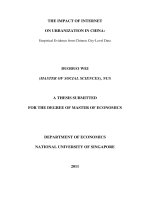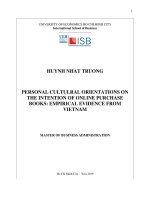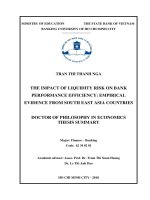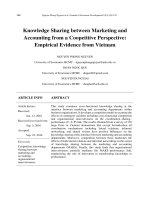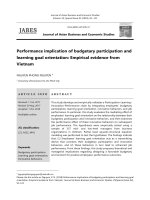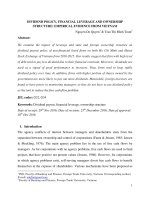Eeffects of challenge and hindrance stressors on employee innovative behavior empirical evidence from vietnam
Bạn đang xem bản rút gọn của tài liệu. Xem và tải ngay bản đầy đủ của tài liệu tại đây (1.09 MB, 84 trang )
VIETNAM NATIONAL UNIVERSITY, HANOI
VIETNAM JAPAN UNIVERSITY
DO HAI YEN
EFFECTS OF CHALLENGE AND
HINDRANCE STRESSORS ON EMPLOYEE
INNOVATIVE BEHAVIOR: EMPIRICAL
EVIDENCE FROM VIETNAM
MASTER'S THESIS
VIETNAM NATIONAL UNIVERSITY, HANOI
VIETNAM JAPAN UNIVERSITY
DO HAI YEN
EFFECTS OF CHALLENGE AND
HINDRANCE STRESSORS ON EMPLOYEE
INNOVATIVE BEHAVIOR: EMPIRICAL
EVIDENCE FROM VIETNAM
MAJOR: MASTER OF BUSINESS ADMINISTRATION
CODE: 8340101.01
RESEARCH SUPERVISORS:
ASSOC. PROF. KODO YOKOZAWA
DR. TRAN THI BICH HANH
Hanoi, 2021
TABLE OF CONTENT
LIST OF TABLES .......................................................................................................... i
LIST OF FIGURES ........................................................................................................ ii
LIST OF ABBREVIATIONS ....................................................................................... iii
CHAPTER 1: INTRODUCTION .................................................................................. 1
1.1. Background of research ....................................................................................... 1
1.2. Research objective ............................................................................................... 3
1.3. Research questions .............................................................................................. 3
1.4. Research scope ..................................................................................................... 3
1.5. Structure of the study ........................................................................................... 4
CHAPTER 2: LITERATURE REVIEW ....................................................................... 5
2.1. Employee innovative behavior ........................................................................... 5
2.2. Challenge stressors and hindrance stressors ....................................................... 8
2.3. The related frameworks of previous research ................................................... 10
2.4. Affective commitment ...................................................................................... 12
2.5. Job autonomy .................................................................................................... 13
2.6. Research gap ..................................................................................................... 14
CHAPTER
3:
HYPOTHESIS
DEVELOPMENT
AND
RESEARCH
METHODOLOGY ....................................................................................................... 17
3.1. Hypothesis development.................................................................................... 17
3.1.1. The relationship between challenge stressors and creativity - oriented work
behavior ............................................................................................................... 17
3.1.2. The relationship between hindrance stressors and creativity – oriented work
behavior ............................................................................................................... 17
3.1.3. The relationship between challenge stressors and implementation - oriented
work behavior ...................................................................................................... 18
3.1.4. The relationship between hindrance stressors and implementation – oriented
work behavior ...................................................................................................... 18
3.1.5. Moderating role of affective commitment ................................................. 19
3.1.6. Moderating role of job autonomy .............................................................. 20
3.2. Conceptual model .............................................................................................. 21
3.3. Research methodology ....................................................................................... 22
3.3.1. Research design ......................................................................................... 22
3.3.2. Sampling .................................................................................................... 23
3.3.3. Data collection process .............................................................................. 24
3.3.4. Scale measurement .................................................................................... 25
3.3.5. Data analysis .............................................................................................. 28
CHAPTER 4: DATA COLLECTION AND ANALYSIS ........................................... 31
4.1. Data description ................................................................................................. 31
4.2. Measurement test ............................................................................................... 32
4.2.1. Reliability test ............................................................................................ 32
4.2.2. Validity test with Exploratory Factor Analysis ......................................... 33
4.2.3. Correlation analysis ................................................................................... 40
4.3. Hypothesis testing.............................................................................................. 41
CHAPTER 5: DICUSSION AND IMPLICATION..................................................... 46
5.1. Discussion .......................................................................................................... 46
5.2. Implication ......................................................................................................... 48
5.2.1. Theoretical implications ............................................................................ 48
5.2.2. Practical implication .................................................................................. 49
CONCLUSION ............................................................................................................ 52
REFERENCES ............................................................................................................. 54
APPENDIX 1: QUESTIONAIRES SURVEY ............................................................ 62
APPENDIX 2: DATA DESCRIPTION OF 267 SAMPLES ....................................... 73
ACKNOWLEGEMENT
To complete this master thesis as marking one of my stone in the journey of studying
master of business administration as well as developing myself, I want to give my deep
gratitude to Assoc. Prof. Kodo Yokozawa and Dr. Tran Thi Bich Hanh, who spent their
time on guiding me to complete this thesis in spite of their busyness. Without their
direction, I could not find the right way to finish the research. Furthermore, they always
gave me a lot of encouragement when I was conducting the thesis. Thank you so much
for not being hesitated to give instruction and motivating me as always.
Besides, there are no words to express my thanks to some PhD students including Mr.
Nguyen Anh Hao, Ms. Phung Thi Xuan Huong, Ms. Pham Thi Thoa, who are supervised
by Assoc. Prof. Kodo Yokozawa in Yokohama National University. They were always
supportive when I met some difficulties. Especially, detail comments and valuable
suggestions were given to me as always by Mr. Nguyen Anh Hao. Then, I could avoid
mistakes as much as possible and have new ideas during this time to complete my thesis.
On this occasion, I also want to give my deep thanks to Ms. Nguyen Thi Huong as a
coordinator in Master of Business and Administration program of Vietnam Japan
University. She was always willing to give me useful recommendations and support
related documents to help me finish this thesis.
Lastly, from the bottom of my heart, I am so grateful that my parents, friends and
colleagues spent their time on giving assistance and encouraging me during the time of
doing the research. They also helped me complete my survey enthusiastically so that I
could complete the thesis.
Thanks to all of them, my journey in Vietnam Japan University has many colors with
worthwhile events that I have to keep in memory.
Sincerely,
ABSTRACT
The number of stressors has been increased nowadays, which have impact on many
aspects in one organization, such as work performance including innovative behavior
among employees. This study attempts to examine the effects of job stressors on
employees’ innovative behavior and the moderating roles of affective commitment and
job autonomy. Data are obtained from 267 employees in some organizations in Vietnam.
Descriptive, variance, correlation and regression analysis are conducted by SPSS 26.0.
Results indicate that stressors that employees tend to appraise as challenge has positive
effects on both creativity – oriented work behavior and implementation – oriented work
behavior, which are as two main oriented – behaviors contributing to innovative
behavior. Meanwhile, hindrance stressors accompanying with affective commitment
would decrease creativity – oriented work behavior, which are different from the
previous research that affective commitment would increase creativity. Those results
would be explained in the discussion part before giving implications for researchers and
practitioners, so that they have suitable interfere on stressors to increase positive or
decrease negative on innovative behavior.
Key words: job stressors, challenge stressors, hindrance stressors, innovative behavior,
affective commitment, job autonomy, COVID – 19.
LIST OF TABLES
Table 2.1: The recent studies about the relationship between stressors and work
performance ...................................................................................................................11
Table 3.1: Measurement items ......................................................................................25
Table 4.1: The general information of respondents ..................................................... 31
Table 4.2: Reliability test ..............................................................................................33
Table 4.3: Validity test for independent variables ........................................................33
Table 4.4: Rotated component matric for challenge and hindrance stressors ...............34
Table 4.5: Validity test for dependent variables ...........................................................35
Table 4.6: Rotated component matrix for creativity – oriented work behavior and
implementation – oriented work behavior ....................................................................35
Table 4.7: Validity test for moderators .........................................................................37
Table 4.8: Rotated component matrix for affective commitment and job autonomy ...38
Table 4.9: The content for each item of affective commitment scale ...........................39
Table 4.10: Correlation coefficient analysis .................................................................40
Table 4.11: Variance Inflation Factor value..................................................................41
Table 4.12: The results of testing hypothesis ................................................................42
Appendix 2: Data description of 267 samples ..............................................................73
i
LIST OF FIGURES
Figure 2.1: Four stages and two oriented – work behaviors of innovative behavior ......7
Figure 3.1: Conceptual model .......................................................................................21
Figure 3.2: Research design by author ..........................................................................23
Figure 4.1: Conceptual model after running EFA .........................................................40
ii
LIST OF ABBREVIATIONS
Abbriviation
Meaning
GII
Global Innovation Index
CS
Challenge stressors
HS
Hindrance stressors
COWB
Creativity – oriented work behavior
IOWB
Implementation – oriented work behavior
iii
CHAPTER 1: INTRODUCTION
1.1. Background of research
Innovative behavior is the foundation of any high - performance organization in the
workplace (Carmeli & Spreitzer, 2009). This is especially apparent in a knowledge based economy where intangible assets come to the forefront (Carmeli & Tishler, 2004)
and play an ever more significant role in enhancing organizational competitiveness and
“doing more with less”. Innovative behavior was described as the intentional creation,
introduction, and application of new ideas to meet new challenges in complex
environments (Janssen, 2000). It is the crucial factor for an organization to exist and
flourish so far in the long term. Because innovative behavior is very important, it
received many interest from authors to identify the correlation relationships on
performance. Through years, researchers keep finding and developing them in as much
detail and diversified as possible. Even, innovation has been developed as the index in
the world, which is Global Innovation Index (GII). Cornell University, INSEAD, and
the World Intellectual Property Organization (WIPO), a specialized agency of the
United Nations, are among the three publishers who collaborate to create this index
every year. Institutions, human capital and research, infrastructure, credit, investment,
linkages; knowledge production, absorption, and diffusion; and creative output are
among the criteria used by the GII to assess innovation (Dutta and Lanvin, 2020). Based
on that, we can look at and evaluate which the current innovation position of one country
is ranking. According to the report “Global Innovation Index 2020”, GII of Vietnam
ranked the first among the 29 lower middle income group economies, and ranks the 9th
among the 17 economies in SouthEast Asia, East Asia, and Oceania. In the world,
Vietnam ranks 42nd among the 131 economies featured in the GII 2020. The number is
quite impressive, however, Vietnam can still improve those ranks, which is based on the
sustainable success of each organization. Therefore, employee innovative behavior
plays an important role in one organization in Vietnam to increase innovation as well as
competitiveness in the fierce environment nowadays.
Therefore, identifying the contextual conditions affecting innovative behavior has
received much interest from researchers. Literally, stressor is one of those conditions,
1
which is mentioned in many psychological and organizational literature (Ren & Zhang,
2015). Meanwhile, practically factors leading to stress among individuals as discussed
above are broadening in COVID – 19 contexts. Hence, stressors can be considered as
the predictors for many types of work performance. According to the transactional
theory of stress (Lazarus and Folkman, 1984), the stressful situations happen when
individuals consider job demands as either challenging or hindering their well – being.
Those situations are caused by some types of stressors such as time pressure (Baer &
Oldham, 2006), job insecurity (Probst et al., 2007), job demand (Janssen, 2000), social
evaluative threats (Byron and Khazanchi, 2010). Each of these had different effects on
the innovative behavior. However, those findings showed the inconclusive results,
which was mentioned as the negative or positive or curvilinear or even non-significant
relationship between stressors and innovative behavior (Canvanaugh et al., 2000;
Janssen, 2000; Baer & Oldham, 2006; Melchior et al., 2007; Probst et al., 2007; Byron
& Khazanchi, 2010; Ren & Zhang, 2015). One possible explanation for the different
results is based on the nature of stressors. Each type of stressors will have effects on the
innovative behavior in the particular directions. Then, Cavanaugh et al. (2000) divided
the stressors into two types: challenge stressors and hindrance stressors. Challenge
stressors are considered as having the potential to gain personal improvement and
mastery, such as time pressure, high workload. When compared to challenge stressors,
such as role ambiguity, red tape, and organizational politics, which act as roadblocks to
achieving positive outcomes, hindrance stressors have negative consequences. In this
paper, two terms will be used to reidentify the relationship between stressors and
employee innovative behavior.
Meanwhile, moderating variables need consideration to ensure the employee innovative
behavior in organization. Identifying which factors to decrease the negative effects or
increase the positive effects of this relationship is necessary to keep and promote
innovative behavior among employees. In this research, affective commitment and job
autonomy will be considered as the moderating variables. Affective commitment makes
the employees have a strong sense of belonging to the organization (Cohen, 2007),
which might check whether it can be motivation for employees to develop innovative
behavior under the stressors. Job autonomy belongs to one of organizational behaviors.
It lets employees determine their own approaches, the pace, and the schedule in order to
2
achieve the goals (Hackman & Oldham, 1975), which can be considered to reduce
stressors to some extent, then avoid affecting negatively on innovative behaviors.
1.2.
Research objective
In conclusion, innovative behavior is very essential for any organization to have long term success. Hence, the contexts influencing innovative behavior have received much
attention. This research identifies the stressor as one of that antecedents. However, in
the previous research, the results showed the inconclusive results, which may be due to
the different nature of stressors. Therefore, this thesis will identify the influence of
challenge stressors and hindrance stressors on the innovative behavior among
employees. Furthermore, moderating effect of affective autonomy and job autonomy
will be identified during the process of reviewing the relationship between stressors and
innovative behavior.
1.3.
Research questions
More specifically, two researched questions in the study are “What types of stressors
affect innovative behavior?” and “Do affective commitment and job autonomy moderate
the effects of stressors on innovative behavior?”.
Based on the results, the theoretical implications will be provided for researchers to
enrich the previous related theories or find the different directions of approaching from
the existing findings. The findings of this study will also provide more empirical
evidence for managers and staff to detect and take advantage of the positive effects of
stressors on their innovative behavior, which leads to high performance in organizations.
Besides, the negative effects will be explored and explained to help employees avoid
those types of stressors producing negative effects.
1.4.
Research scope
The researches on stressors and employee innovative behavior in organizations in
Vietnam have been limited. Even more, Vietnam still has many works to improve the
Global Innovation Index to enhance competitive advantages among countries or regions.
Especially, in the context of many stressors nowadays, there are many unexpected
effects on employee innovative behavior. Therefore, research in Vietnam is necessary
to identify so that the managers in organizations apply the implications into their
3
organizations to decrease the negative effects or increase the positive effects if any. The
samples were conducted in Vietnam in the period from February, 2021 to March, 2021.
1.5.
Structure of the study
There are seven main parts to construct this research. Firstly, the necessary of
conducting this research is discussed as above. Then, literature review part is to
summary the information and research stream of innovative behavior and stressors, as
well as reviewing the previous research and providing the concepts used in this research.
A conceptual model will be demonstrated based on this, including hypothesis
development and explanation in the hypothesis development section. To test whether
that hypothesis is supported or rejected, research methodology, data collection, and
analysis will be provided. Next, the findings and discussion will be shown to compare
with the existed research and explain why those results happen. Finally, theoretical and
practical implications will be provided to contribute to academic aspects as well as
businesslike aspects. Besides, limitation and future research will be discovered after
going to conclusion.
4
CHAPTER 2: LITERATURE REVIEW
The author reviewed many previous researches about stressors, innovative behavior,
affective commitment, and job autonomy. Each variable was summarized by the time
and other researchers, so that the author can have an overview of research stream. After
that, selection of key variables would be based on the consistency of using those terms
and the way of definitions among researchers through high qualified published papers.
If it exists any differences, the author would find the reasons that could explain for the
existing distinction. Besides, more evidences from many theories to link the way of
definition research was one of approaches for the author to use the chosen variables in
this research.
2.1. Employee innovative behavior
Two terms of creativity and innovation have been used correspondently. However, they
are distinct from each other in the previous research. Mumford and Gustafson (1988)
define creativity as the practice of coming up with new and beneficial ideas. It just
stopped at the idea generation step, whether it was applied into practical situations or
not was not mentioned. There are some ideas that are very interesting, attractive but not
applicable. In contrast, there are some ideas having high applicable properties into
practice. Therefore, later the term of innovation was created, which had a wider meaning
than creativity. Following Kanter (1988) and Van de Ven (1986), innovation is
illustrated as a multistage process, at which each stage includes different activities in
charge by different individuals when applying ideas into practical situations. The
intentional production, introduction, and implementation of new ideas to address new
difficulties in a complex environment was then termed as innovative behavior as a result
of innovation (Janssen, 2000). It is necessary for employees to have high performance
in one organization, which leads to increase competitiveness. Especially, it has been also
linked to sustainable development. The results of one research of Janssen in 2000 said
that there was the existence between sustainable development and innovation, especially
related to individuals’ response to innovation. It was illustrated that innovative behavior
has been important to organization in the long – term success. Therefore, it was paid
attention by many researchers to identify clearly the correlation relationship of
innovative behavior.
5
Innovative behavior was described as a set of behavioral activities combining four
stages: problem recognition, idea generation, idea promotion, and idea realization (Scott
& Bruce, 1994; Janssen, 2000). De Jong & Den Hartog (2010) used other terms to
illustrate those four stages, which include exploration, generation, championing, and
executing of the ideas to evaluate the innovative behavior. Each stage would have the
different characteristics in charge by different members as long as to achieve the
innovation target. Before generating new ideas, employees engaged in discovering
opportunities, realizing the performance gaps or finding the solutions of the problem (de
Jong & Den Hartog, 2007). It meant that there would be some issues underlying
expectations and needing to be filled. The next stage would be the idea promotion or
championing to potential allies. At this time, employees needed to find supporters,
partners, sponsors to build an alliance to support those new ideas (Kanter, 1988). Those
people would give the power or consultant to have the suitable directions when
implementing the ideas. Innovative behavior would be completed by the idea realization,
which produced a prototype or model of innovation for employees or individuals to
ultimately apply in the group or organization’s goals (Kanter, 1988). Each stage was
divided separately with different activities and different individual behaviors; therefore,
individuals could participate in one or any merger of stages at any one time (Scott &
Bruce, 1994).
As discussed, both creativity and implementation were the essential components to
contribute to the employee innovative behavior (Axtell et al., 2000). The components
had the representative for each two stages. Therefore, this paper will take into two
components in defining innovative behavior among employees as two oriented
behaviors. Following Dorenbosch et al (2005), they divided this set of four stages into
two oriented behavior, which was based on the degree of flexibility of one job. The first
two stages cover the concept of creativity – oriented behavior, at which individuals will
start with recognizing problems within their work before the production of new ideas to
cover them. The last two stages contain the notion of implementation – oriented
behavior, including calling sponsorship for new ideas and attempting to establish an
association to support them before realizing the actual ideas to apply in practical
contextual within the work – role.
6
Problem
recognition
Idea
generation
Creativity – oriented work
behavior
Idea
promotion
Idea
realization
Implementation – oriented work
behavior
Figure 2.1: Four stages and two oriented – work behaviors of innovative behavior
(Scott & Bruce, 1994; Janssen, 2000; Dorenbosch et al., 2005)
Being awareness of the important level of innovative behavior, many authors have been
finding which factors affect innovative behavior such as leadership, work group,
individual attributes (Scott & Bruce, 1994); workplace environment, coworker support,
job stress (Bani-Melhem et al. 2017); knowledge sharing, organizational climate (Yu et
al. 2013); time pressure (Baer & Oldham, 2006). Those findings in many previous
research showed that several factors could increase the employee innovative behavior,
and some other factors could decrease the employee innovative behavior.
Stressors, which were previously thought to be indispensable factors in the workplace,
have now been identified as environments that influence job outcomes such as
innovative behavior (Ren & Zhang, 2015; Cavanaugh et al., 2000; Byron & Khazanchi,
2010). Job stressors are as the source of stress (Beehr & Newman, 1978), which occurs
when demand are placed on the person which exceed his or her ability to adjust (Lazarus,
1976). Many researchers have found that stress is correlated with a wide arrange of
negative effects for decades. Work stress can cause weariness, trouble sleeping, poor
concentration, and distress (Melchior et al., 2007). Many researchers and practitioners
have been interested in the positive impact of stress on results in recent years, such as
personal change or growth (Tedeschi et al., 2018). Therefore, the reason for reversed
effect of stress on outcomes is essentially important for researchers and practitioners to
interfere effectively on the job, such as decrease the negative effects and increase the
positive effects.
7
2.2. Challenge stressors and hindrance stressors
In accordance with Job Demand – Resources Theory (Bakker & Demerouti, 2014), job
demands mention two facets of the job that takes constant physical, psychological effort,
paralleling with certain physiological or psychological costs. Job demands can also be
categorized as psychological stressors, such as the need to work quickly and efficiently,
having a large amount of work to complete in a short amount of time, or a high workload
(Fox et al., 1993). Although job demands are not always bad, they might turn into
hindrance claims if they involve a lot of effort that the employee hasn't recovered from
(Bakker & Demerouti, 2014). That means, stressors as the consequence of job demands,
can be good or bad to the individual in performance at work. If they are the good
stressors, it will create the positive attitudes among employees, and vice versa, if they
are the bad stressors, they will create the negative attitudes.
When job demands are perceived as gratifying work experiences that are well worth the
inconvenience, McCauley et al. (1994) labeled these job demands as challenges for
example job overload, time pressures, and high levels of responsibility, which produce
positive feelings. Cavanaugh et al. (2000) defined it as challenge - related self – reported
stress associated with challenging job demands, which are under employee’s control,
leading to be manageable. Similarly, Lazarus & Folkman (1984) labeled the stressful
situations with potential promoting mastery, personal growth, or future gains as
“challenges”. Then, this sort of stress is called a challenge stressor by Ren and Zhang
(2015) because it includes demanding demands that people see as possibilities for
growth, learning, and achievement.
Stress associated with job demands or work circumstances that involve excessive or
undesirable constraints interfering with or hindering an individual's ability to achieve
valued goals is referred to as hindrance – related self – reported stress, as opposed to
challenge – related self – reported stress (Cavanaugh et al, 2000). It means that there
were stressful situations with potentially threatening or hindrance. This type of stress
was caused by hindrance stressors, which were viewed by individuals as obstacles to
personal improvement and goal achievement, such as organizational politics, red tape,
role ambiguity, and concerns about job security (Ren & Zhang, 2015). Those barriers
8
are unmanageable or out of control of the employee's hands. Therefore, the name of
hindrance brings more negative implications for employees in the organization.
Both challenge stressors and hindrance stressors are considered as factors to cause
strains, which include anxiety, exhaustion, depression, and burnout (Jex, 1998). Then,
Lepine et al. (2005) gave the same expression of stressors, which are the provocation to
induce the stress process; and strains are the consequences in this proceeding. However,
in some situations counting on the essence of stress, the results in work performance
vary. The initial appraisal process of both types of stressors provoke specific emotional
responses, that in turn influence the employees’ behavior (Lazarus & Folkman, 1984;
Spector, 1998; Duhacheck & Iacobucci, 2005). Challenge stressors will create positive
emotions (acting as confidence and enthusiasm) and strong belief, leading individuals
to have an active solving - problem style (Wallace et al., 2009. In contrast, hindrance
stressors typically have the opposite effect due to the negative emotions like distraction,
withdrawal, which leads to the passive emotional coping style (Wallace et al., 2009). In
an active solving - problem style, employees are more likely to adapt with new changes
and increase potential effort to overcome challenges to achieve the valued gains.
Alternatively, passive emotional coping style induces employees to decrease effort
because they perceive that those problems are beyond their control.
In the study of Cavanaugh et al. (2000), they used challenging job demands and
hindrance job demands as the feeling of eustress and distress, respectively. According
to Selye (1982), eustress had been considered feeling of fulfillments and achievement
through challenges, while distress was defined as adverse to eustress. It illustrated that
not all stress is bad; it can also produce positive outcomes and force positive changes.
Therefore, stressors as two such directions could lead employees into two ways to cope
with stress: adjusting oneself to intensified demands or modifying work circumstance
(Edwards & Cooper, 1990). Based on that, it can be understandable that stressors will
activate workers to adapt oneself by enhancing skills, knowledge, ability to meet the
high job demands; or rework his or her context by changing their tasks, methods, work
objectives, or job design. The former activity can be considered as manageable as
enhancing skills, abilities; and the latter activity considered as unmanageable with some
employees as changing the work environment, job design or work objectives. Those
9
activities as the effective ways influence innovation to deal with heavy workload, as
well as job demands (Bunce & West, 1994).
2.3. The related frameworks of previous research
There were many researches about the association between stress and work outcomes.
Lepine et al. (2004) published a study that found a link between challenge and hindrance
stress and learning performance, with the moderating effects of motivation to learn and
exhaustion. The result showed that challenge stress had positive impact on learning
performance, while hindrance stress had the reversed effect. The same result was shown
as in the relationship between challenge stressors, hindrance stressors and role-based
performance (Wallace et al., 2009). It is not different from the Cavanaugh et al.’s
findings in 2000, which showed that challenge self – reported work stress is positively
related to job satisfaction, while hindrance self – reported work stress is negatively
related to job satisfaction. Lukasik et al. (2019), on the other hand, found no link
between stress and working memory performance. The association between time
pressure and creativity also yielded a non-significant result (Baer & Oldham, 2006).
Besides, other research showed that the threat of losing one’ job as job insecurity
(considered as one type of stressor) has the negative impact on creative problem –
solving abilities (Probst et al., 2007). The curvilinear effect of this relationship between
stressors and creativity was also found in the research of Byron & Khazanchi (2010).
Those results demonstrate the inconsistent conclusion regarding the relation between
stressors and work outcomes like learning performance, role-based performance, job
satisfaction, creativity, working memory performance. A plausible explanation for this
depends on the level of stress that participants responded or the nature of stress that
participants experienced. Stress increased arousals, which leads performance increase
to one point, then there will an overarousal, strain, then decrease performance (Yerkes
& Dodson, 1908). Another explanation for the inconsistent results in such research is
the nature of stressors, like challenge stressors and hindrance stressors. Each type of
stressors leads to the different effects on work outcomes.
The relationships between stressors and work performance in recent literature are
summarized in table 2.1.
10
Table 2.1: The recent studies about the relationship between stressors and work
performance
Author & Year
Cavanaugh et al.
(2000)
Independent
variables
Challenge
stressors
Hindrance
stressors
Effects*
Dependent
variables
Methodology
Sample
s/+
Job
satisfaction
Job search
Job
satisfaction
Job search
Innovative
work behavior
Survey
1886
Survey
280
Learning
performance
Survey
871
s/s/-
Janssen (2000)
Job demand
s/+
s/+
Lepine et al.
(2004)
Challenge stress
s/+
Hindrance stress
s/-
Baer & Oldham
(2006)
Time pressure
ns
Creativity
Survey
170
Melchior et al.
(2007)
Job demand
s/+
Disorder
Survey
972
Probst et al. (2007)
Job insecurity
s/s/+
Creativity
Productive
work behavior
Laboratory
experiment
248
Wallace et al.
(2009
Challenge
stressors
s/+
Role - based
performance
215
Hindrance
stressors
Stressors
s/-
Survey +
supervisor's
evaluation
Meta - analysis
86
Survey
503
Byron &
Khazanchi (2010)
Lukasik et al.
(2019)
Curvilinear
Social evaluative
threat
Curvilinear
Uncontrollability
Stress
s/ns
Creativity
Working
memory
performance
*Note: s/+ (positive significance), s/- (negative significance), ns (non-significance)
Table 2.1 shows an inconsistent result in effect of stressors on innovative behavior in
many previous studies. As such, the effect could be positive, negative, curvilinear, or
non-significant. The contradiction can be explained by the fact that past studies had
different research contexts, or there could be other major elements that temper the
association between stressors and innovation. This study will re-examine whether
challenge and hindrance stresses influence employee innovative behavior in the
Vietnamese environment, a question that has yet to be answered in the literature.
11
Affective commitment and job autonomy are also proposed as crucial moderators to
enhance the positive effect or decrease the negative effect of stressors to ensure
innovative behavior among employees. Affective commitment is the sense of belonging
to one organization (Cohen, 2007), which is related to psychological attachment that
any employee experiences to make decision of working in long term or short term at
one organization (Mowday et al., 2013). Hence, whether it can reduce the negative
influence of stressors on innovative behavior will be examined. Job autonomy is
belonging to the organizational behavior, which can let employees determine their
methods, pace, and schedule (Hackman & Oldham, 1975). Therefore, it will be useful
if it can reduce the negative effects on the stressors – innovative behavior relationship.
The author also determined the extent to which affective commitment and job autonomy
could explain the different relationship between two forms of stressors and innovative
behavior.
2.4. Affective commitment
One sort of organizational commitment is affective commitment. Meyer and Allen
(1991) developed a model of commitment including three approaches: affective,
continuance, and normative commitment. Affective commitment was mentioned as the
emotional attachment to the organization, which was best described by Porter and his
colleagues who defined commitment as ‘the relative strength of an individual’s
identification with and involvement in a particular organization’ (Mowday et al., 2013).
Another sort of commitment is continuation, which occurs when there is a benefit to
continuing participating but a cost to leaving (Kanter, 1968). However, in this way of
definition, a cost associated with leaving would overlap with outcomes such as turnover
intention. The third type of commitment is normative commitment, which was described
as one’s responsibility to the organization. The behavior in the organization would be
exhibited only because they believe it is the right and moral things to do (Wiener, 1972).
Other authors identified it as the personal norms to contribute to such behavior
(Schwartz & Tessler, 1972). Then, Meyer and Allen (1990) labeled key words for each
kind of commitment: affective commitment remains because employees want to, those
with strong continuance commitment because they need to, and those with strong
normative commitment because they ought to do.
12
However, Cohen (2007) reconceptualized organizational commitment as two dimensional based on the nature of commitment: instrumental considerations and
psychological attachment. The first dimension focused on the benefits of staying at the
organization like instrumental exchange, instead of including in leaving the organization
as Kanter (1968) defined. It helped to avoid any potential overlap with outcomes like
turnover intentions (Cohen, 2007). In this dimension, calculation was involved in
employees’ thoughts. They saw an equitable exchange between their contributions to
the organization and the rewards they received, which can be considered as the tangible
exchange relationship. The second dimension was mentioned as normative or affective
commitment, which required moral obligation to be involved in the organization. In this
dimension, emotional attachment occurred through internalizing the organization's goals,
values and norms.
In previous studies, there was limited research to use affective commitment as the
moderator in the relationship between stressors and employee innovative behavior.
Affective commitment was usually considered as the independent variables or
dependent variables in research, instead of as the moderator. Besides, it was rarely
mentioned separately with the rest type of commitment. It is included in the
organizational behavior, and the innovative behavior is also considered as in the
organizational behavior too. Therefore, whether affective commitment has a specific
moderating effect on the relationship between stressors and innovative behavior is tested
in this current study.
2.5. Job autonomy
Job autonomy is considered as one of important and prominent job design features
(Karasek & Theorell, 2010). Hackman and Oldham (1975) interpreted job autonomy as
“the degree to which the job provides substantial freedom, independence, and discretion
to the individual in scheduling the work and in determining the procedures to be used in
carrying it out”. Then, this way of definition was used in many other research studies
(Morgeson et al., 2005; Breaugh, 1985; Ng et al., 2008; Zhang et al., 2016; Volmer et
al., 2012). It was illustrated as the extent to which employees could regulate their own
approach, the velocity to finish jobs, and the schedule to achieve the target. The
individuals having the high job autonomy would be more flexible in defining their roles
13
because they are adjustable to decide how to perform their work (Troyer et al., 2000).
Then, self-determination and freedom from external controls or constraints were
considered as the consequence of autonomy (Deci et al., 1989).
Job autonomy usually researched under the job demand - control model (Karasek &
Theorell, 2010). Job control referred to how much discretion employees have in the
working process and scheduling, which had the similar meaning with job autonomy.
Based on job demands - resources theory (Bakker & Demerouti, 2007), job autonomy
was considered as one of the job resources and influenced work engagement. Besides,
in self-determination theory, it was said that employees would be more creative in
autonomy - supportive environments (Ryan & Deci, 2000).
Individuals with greater job autonomy will have more responsibility for their job (Parker
& Sprigg, 1999). In meta – analytic study conducted by Spector’s (1986), the result
showed that autonomy could make employees higher satisfaction, organizational
commitment, job performance, and motivation; meanwhile, decrease the negative
effects of distress, role conflict, ambiguity, and turnover. Besides, in the correlation with
creativity studied, employees with high job autonomy are more creative when they are
in the good connection with their supervisors (Volmer et al., 2012). However, the
negative association of job autonomy on performance has been found by Langfred and
Moye (2004). Not all employees with high autonomy said that they had the positive
attitudes (Ng and Feldman, 2014). Even, within a team, the relationship between job
autonomy and performance has been non – significant (Man and Lam, 2003). Moreover,
this association has been also depending on task uncertainty (Cordery et al., 2010), task
interdependence (Langfred, 2005), work demands climate (Hirst et al., 2008).
Those relationship of job autonomy is not consistent in any effects as discussed.
Therefore, in the moderating role in the association of stressors on innovative behavior
will be tested with the aim of checking whether it decreases the negative effects or
increase the positive effects.
2.6. Research gap
Literature review indicates that innovative behavior has been focused by a few of
scholars for a few decades. It is the essential factor in the organization to have the
14
excellent performance and to compete with the strong rivals. To establish innovative
behavior among employees, the antecedents need identifying such as stressors, which
always exist in any organization and have impact on employees to some extent.
However, the relationship between stressors and work performance including
innovative behavior has not been consistent. Some research found that it was the positive
relationship, other research said that it was the negative or non-significant relationship.
The reason for the different results may depend on whether authors measured stressor
variables by the nature of stressors or the level of feeling stress among participants.
Another explanation for the inconsistent findings is that different moderators can be lead
to the different effects on the relationship between stressors and innovative behavior.
In current research, the nature of stressors will be measured by dividing them into two
types: challenge stressors and hindrance stressors. Besides, the innovative behavior will
be divided by the oriented - behaviors, instead of four stages as the previous research.
Those behaviors are creativity oriented - work behavior and implementation oriented work behavior. Meanwhile, affective commitment and job autonomy will have different
moderating effects on this relationship, which will be able to explain to some extent the
inconsistent results in the previous research.
Therefore, this research will identify the relationship between hindrance stressor,
challenge stressors and two oriented work of innovative behavior and what will happen
with the moderators of affective commitment and job autonomy in this relationship. The
research questions are “What types of stressors affect innovative behavior?” and “Do
affective commitment and job autonomy moderate the effects of stressors on innovative
behavior?”.
These answers of two research questions provides researchers the effects of challenge
stressors and hindrance stressors on innovative behavior in Vietnamese context. The
results in Vietnamese context might be not consistent compared with the context in
previous researches. Thus, researchers can have different views of stressors on
innovative behavior among employees. Based on that, they can develop one distinct
aspect of stressors and innovative behavior to contribute to the built theories, meanwhile
practitioners can get some implications to have suitable interfere on stressors to promote
innovative behavior among employees in their organizations. In the case that the results
15
are consistent with the many previous research, it enhances that those findings could be
applied to a variety of organizations or industries or countries or regions.
16
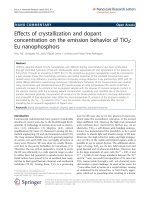
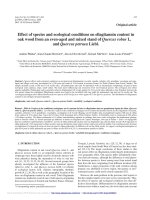
![al-thuneibat et al - 2011 - do audit tenure and firm size contribute to audit quality - empirical evidence from jordan [at]](https://media.store123doc.com/images/document/2015_01/06/medium_qq9ifLC9q1.jpg)
